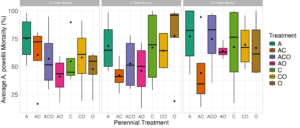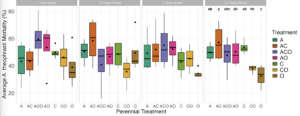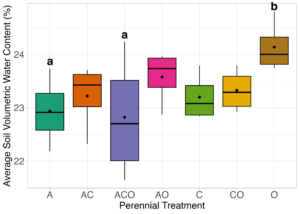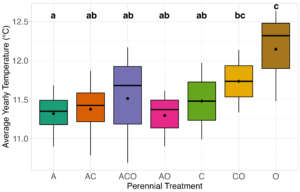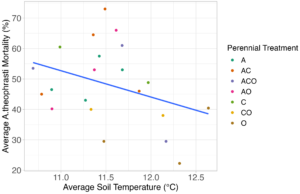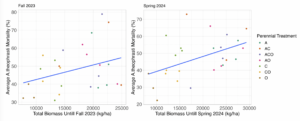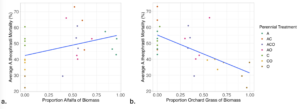Progress report for GNE24-308
Project Information
Leveraging the soil microbial community to accelerate weed seed mortality in the soil could be a novel approach to ecologically manage weedy populations. With NE SARE funding, we examine whether natural crop-microbe-weed seed interactions can increase the soil microbes that accelerate weed seed mortality. Perennial forage crops have been shown to effectively reduce annual weed populations by disrupting weed life cycles, but one major knowledge gap remains: To what extent do diverse perennial crop mixtures affect weed seed mortality in the soil through microbial activity or abiotic conditions? Our treatments (7) include monocultures and all two- and three-species combinations of a perennial legume, forb and grass: alfalfa (Medicago sativa), forage chicory (Cichorium intybus), and orchard grass (Dactylis glomerata). We examine two weeds, Powell amaranth (a pigweed; Amaranthus powellii) and velvetleaf (Abutilon theophrasti), which are problematic on Pennsylvania farms. At the start of the experiment, we buried weed seeds within mesh bags in perennial treatments with retrieval of subsamples after 1, 1.5, 2 and 2.5 years of burial. Currently, we have measured soil abiotic conditions and conducted weed seed viability testing up to year 2, with a final sampling in May 2024. Currently, with this grant, we are conducting a thorough analysis of soil abiotic factors and weed seed endophyte and soil microbial composition through Illumina 16S and ITS amplicon sequencing. Results will be shared through multilingual PSU Extension Events, a presentation in Spanish at a regional grower convention, national and local scientific meetings, and a bilingual Amaranthus weed ID brochure.
Objective 1: To what extent does the weed seed microbiome vary across time, and does the weed seed microbiome predict weed seed mortality?
Hypothesis 1: We hypothesize that seed microbiomes detected in our weed seed samples will predict seed mortality, and specifically, we hypothesize that samples with higher weed seed mortality will be colonized by more saprophytic and pathogenic microbes compared to seeds with higher mortality. Based on preliminary data, we have found greater microbial diversity in lower viability seeds compared to higher viability seeds, suggesting that the weed seed samples within our burial bags lose viability as they are colonized by the more diverse soil microbial community.
Objective 2: Is weed seed mortality and the weed seed microbiome predicted by the soil microbiota?
Hypothesis 2: We hypothesize that samples with higher weed seed mortality are colonized by more saprophytic and pathogenic microbes than seeds with lower mortality rates. These endophytic microbes will be reflected in the soil microbiota surrounding the weed seeds.
Application of Objectives 1 and 2:
With increased understanding of microbial taxa and/or communities that are associated with weed seed mortality in the soil, this will open the door for future research into management practices that increase these microbes to reduce the density of the weed seedbank. In the future, farmers may be able to test for the microbial weed-suppressive-potential of their soil or implement management practices to support those microbial populations, even possibly in the form of an inoculant.
Objective 3: Do soil abiotic factors predict weed seed mortality and the seed microbiome?
Hypothesis 3: We hypothesize that warmer soil conditions and higher N content will be associated with higher weed seed mortality due to increased microbial activity or induction of seed fatal germination.
Application of Objective 3:
If warmer temperatures are associated with weed seed mortality, horticultural producers could alter soil temperature at smaller scales through the use of black plastic mulch, high tunnels, or tarps. If soil nitrogen is associated with weed seed mortality, then targeted application of manure or synthetic nitrogen fertilizer would be an option for accelerating weed seed mortality in the soil.
The purpose of this project is to determine the effect of perennial crop diversity and associated biotic (microbial) and abiotic factors on weed seed mortality in the soil seedbank, which could lead to viable ecological weed management strategies.
Weed control is the greatest challenge for organic producers (Snyder et.al. 2022) and an obstacle for all farmers. Environmental and human health concerns have ignited support for agroecological weed management, especially as the Northeastern US is categorized at medium to high risk of pesticide pollution (McCauley et. al.2022; Sabio and Spers 2022; Tang et.al. 2021). Additionally, increasing herbicide-resistance (Heap 2024) causes conventional growers to seek alternative control methods (McCauley et. al.2022) as herbicide-resistant weeds cost US farmers about $10 billion/year due to losses (Palumbi 2001). Consequently, there is an incentive to examine agronomic factors which reduce existing weed seeds in soil seedbanks to decrease weed populations (Schwartz-Lazaro and Copes 2019).
Weed seeds in the soil are vulnerable to mortality, suggesting a potential method of weed control. Seeds have chemical defenses in their seed coats, and hard, thick seed coats (e.g. velvetleaf) enable seeds to persist in the soil for years (Davis et.al. 2016; Houlihan et.al. 2019). However, once the coat is cracked or penetrated, the seed is highly vulnerable to mortality. Pathogenic and saprophytic bacteria and fungi can result in ≤50% mortality of weed seeds in the soil but this varies across seed species, environmental conditions, and burial depth (Davis et.al. 2005; Chee-Sanford 2008; Wagner and Mitschunas 2008)
Thus far, few studies have examined the microbes that may cause seed mortality. Previous studies either examined general microbial communities but did not identify the specific microbial taxa (e.g. PCR DGGE; Davis et.al. 2006) or relied on culture-based methods (Chee-Sanford 2008) which are limiting as most microbes cannot be cultured. Therefore, we use Illumina Next-Generation Sequencing (16S and ITS amplicons) to examine the bacterial and fungal communities associated with weed seed mortality in a perennial forage diversity gradient.
Perennial crops grown for silage or hay can provide unique weed management benefits. The continual (and often dense) plant cover within perennial forages suppresses annual weed emergence and frequent mowing terminates weeds before set seed, thereby eliminating seed input into the seedbank (Meiss et.al. 2010; Nichols et.al. 2015). Increasing plant diversity in perennial forages can increase forage quality, and decrease disease and density regulation feedbacks compared to monocultures (Vukicevich et.al. 2016). However, it is not yet clear whether perennial forage species or plant functional groups can affect weed seed mortality through their effects on the soil microbiome or soil abiotic factors. Therefore, we examine how monocultures and mixtures of legume, grass and forb perennial forage crops affect weed seed mortality.
Additionally, we investigate whether perennial forage crop effects on weed seed mortality may be mediated through effects on the soil and seed microbiome and soil abiotic factors. Plants influence the soil microbiome, especially the rhizosphere, through N-fixing mutualisms, rhizodeposits, root architecture, and through litter inputs and decomposition (Drost et.al. 2020; Lowry et.al. 2024; Mafa‐Attoye et.al. 2023). Perennial crops may be especially strong at influencing the soil microbiome due to increased labile soil carbon and root exudates compared to annual cropping systems (Sprunger and Robertson 2018; Gallandt et.al. 1999). Organic matter inputs from functionally diverse perennial crops have varying effects on the C:N ratio, and a lower C:N ratio was associated with higher microbial predation of Abutilon theophrasti (Roumet et.al. 2016; Davis 2007). Additionally, the nitrate from legume tissue decomposition has been associated with increased Amaranthus powellii mortality, possibly due to fatal germination (Mohler et.al. 2018). While this ecological system could be driven by abiotic soil nutrients, research suggests that soil abiotic factors interact with soil microbes to influence microbial colonization in seeds, and ultimately seed mortality. Therefore, we examine if soil microbial diversity differs by perennial forage treatment and if differences in soil microbial diversity are associated with the weed seed microbiome and mortality.
This research and anticipated outreach efforts will contribute to Northeast SARE's outcome statement by increasing farm sustainability, resilience, and economic viability through determining the microbial taxa responsible for weed seed mortality in the soil. Ultimately, this will enhance our ability to develop more ecological approaches to weed management by understanding how crop species and soil abiotic factors promote microbially-mediated weed seed mortality. By communicating our findings in Spanish to under-served Hispanic farmers, we hope to help remedy inequities in access to weed management information.
Cooperators
- (Educator and Researcher)
- (Researcher)
Research
January 2025 Update
By the summer of 2024, we completed all field measurements, including soil abiotic factors and the final seed bag retrieval. In Fall 2024, we concluded seed viability testing from the Spring 2024 seed bag retrieval and we extracted DNA from the Spring 2024 seeds and soil samples. In November 2024, we submitted all 16s and ITS PCR products from seed and soil samples for amplicon sequencing on a Next Seq2000 at the Huck Institute's Genomics Core Facility at Penn State. Currently, we are analyzing microbiome sequencing data and processing soil N samples. We also have preliminary results for analyses of weed seed mortality, some soil abiotic factors (temperature and moisture) and biomass.
In 2021, the perennial forage diversity gradient was established by the Lowry Weed Ecology Lab. Through a small seed grant from the Weed Science Society of America (WSSA Innovation Grant), we obtained funding for microbial sequencing of the weed seed microbiome for only a single timepoint. Additional funds from NE SARE will be used to analyze the seed and soil microbiomes and soil abiotic factors at additional timepoints over the study duration (2.5 years) which will improve our understanding of how crop species and soil abiotic factors influence the soil microbial communities and colonization of weed seeds over time.
Experimental Design and Study Site
All objectives
The field site was established in September 2021 as a randomized complete block design with four blocks (4x7) at the Russell E. Larson Agricultural Research Center in Rock Springs, PA (40° 43′N, 77°56′W). Soils are predominately comprised of Hagerstown silt loam (fine, mixed, mesic Typic Hapludalfs). Average air temperature at the site is 50.7°F with average winter temperatures of 29.5°F and average summer temperatures of 70.3°F; the site receives on average 41.53 inches of annual precipitation (NCEI 2024).
To evaluate the effect of perennial forage composition and diversity on microbial or abiotic mediated weed seed mortality in the soil seedbank, we examined 7 perennial treatments including monocultures and all possible mixtures of alfalfa (A)(Medicago sativa - legume), orchard grass (O)(Dactylis glomerata - grass), and forage chicory (C)(Cichorium intybus - forb) and are hereby represented as A, C, O, AC, AO, CO, ACO.
Each block consisted of 7 plots, each plot measuring 12.2x12.2m. See Appendix Figure 1.
Agronomic Management: Prior to planting, the field was chisel plowed, disked, and then a soil finisher and cultimulcher were used to prepare the seedbed. Alfalfa, chicory, and orchard grass were drill seeded on 19-inch rows (see Appendix Table 1). Due to establishment challenges, we had to reseed the chicory and alfalfa in April 2022 and at this time we also applied nitrogen (urea 46-0-0) to all plots at 26.8lb/ac. In June 2023, fertilizer was applied according to soil test recommendations (N: 50lbs/ac, P:100lbs/ac, K: 140lbs/ac). We applied pesticide once (July 2022) for the control of leaf hopper, but no other pesticide nor herbicide has been used. The field is mowed 4x/year when the alfalfa is at bud to early flowering stage, dried and baled for hay.
Abiotic Monitoring
Objective 3
We recorded soil moisture (VWC) weekly during the growing season (early May – late Oct) using a HydroSense II soil probe. Soil temperature readings were collected via HOBO sensors (1 per plot) which collect data every hour and were buried 5cm (2in) below the soil surface, which corresponds with the depth of the seed bags. Soil samples were collected twice per year for nitrogen analysis and once per year (May) for a full spectrum Mehlich 3 (ICP) analysis for pH, Mehlich buffer lime requirement, phosphorus, potassium, magnesium, and calcium.
Biomass Collection
All objectives
Forage biomass was collected 4x per year (immediately prior to the field being mowed for harvest) within a 0.25m2 quadrat (2 samples per plot), when alfalfa was at bud stage. Biomass was cut using electric hand sheers 5cm (2in) above the soil surface, sorted to species, dried at 60°C and weighed.
Weed Seed Mortality Assessment, Soil Microbial Sampling, and Processing
All objectives
Weed seeds of Powell amaranth (a pigweed; Amaranthus powellii) and velvetleaf (Abutilon theophrasti) were collected in October 2021. A. powellii is a problematic and increasingly herbicide-resistant species (Aicklen et.al. 2022) and A. theophrasti is a persistent species in the weed seedbank due to its hard seed coat (Davis et.al. 2016). We used an air column to remove chaff and poor-quality seed and then treated A. theophrasti seed with chloroform for 24hrs to control for velvetleaf seed beetle (Althaeus folkertsi). We sealed weed seeds (100 A. theophrasti and 150 A. powellii) by machine sewing into fine mesh bags with 10g sieved soil from the field site to maintain soil-seed contact. In October 2021, we buried weed seed bags (20 per plot – 10 of each species) 5cm (2in) deep on the edge of a row or section of vegetation (chicory).
We first retrieved weed seed bags from the field at year 1 (Fall 2022) and then subsequently at 6-month intervals (Spring 2023, Fall 2023, and Spring 2024). At each timepoint, we retrieved 2 seed bags of each species per plot and immediately placed them on ice to limit disruption of the weed seed microbiome. Additionally, soil samples were collected from soil immediately surrounding the seed bags (to examine the soil impact on possible seed microbial shifts) and frozen for microbial analysis (Fall 2023 & Spring 2024 only).
After retrieval, we washed the contents of each seed bag individually in EtOH sanitized sieves and counted all intact seeds per bag; this initial count was the recovery count.
Equation 1:
% Recovery = (# of seeds recovered) / (# of seeds originally placed in bag)
We counted 100 A. powellii and 11 A. theophrasti seeds (equivalent to ~ 100mg) and immediately placed them on ice for microbial processing. Within 24 hours of washing the seed bags, we surface sterilized (10% bleach for 10 min with 3 rinses in sterile water)(Ercoli et.al. 2007; Chakrabarti 1977) and freeze dried the seeds designated for microbial analysis. The remaining seeds were stored at 4°C for viability testing. See Appendix Figure 2.
To evaluate weed seed viability, we conducted tetrazolium (TZ) testing according to the AOSA handbook (Miller 2010) using 0.1% TZ with minor alterations; A. powellii seeds were pierced instead of bisected for TZ staining and then later dissected and A. theophrasti seeds were nicked (scarified) to quicken imbibition. To account for the microbial subsample of unknown viability, total weed seed viability (Vtotal) was calculated as:
Equation 2:
Vtotal = (% Recovery) x (% TZ viable)
Seed mortality data analysis:
To determine whether perennial forage community influences weed seed mortality, we used generalized linear mixed effects models with a beta distribution (recommended for proportional data) with forage treatment as a fixed effect and block as a random effect. All data analyses will occur in R (version 2023.09.1).
Microbial DNA Extraction and Sequencing
All objectives
We used the Qiagen DNeasy Plant Mini Kit to extract DNA of seed endophytic microbes. The Qiagen kit's 20mg restriction of biological tissue greatly limits the number of seeds we could extract from (ex. For velvetleaf, 3 seeds may reach 20mg). To obtain a more representative sample, we pooled subsamples to reach an initial 40mg (2x) weed seeds, ground in a bead mill, and doubled the extraction solutions for the initial steps. Then only 1x of lysate (350uL) was put into the Qiagen Shredder Column and normal protocols were followed thereafter. We extracted DNA from soil, frozen from field collection, using the Qiagen Power Soil Kit. Extracted DNA was quantified using a Qubit Fluorometer. We then used a two-step PCR approach to construct amplicon sequencing libraries: 1) amplification of ITS 1-2 marker region for fungal taxonomic diversity and 16S rRNA gene using 515F v4 (Parada) - 806R v4 (Apprill) primers for bacterial taxonomic diversity; 2) attach index barcodes and remaining Illumina adapters for sample identification and to complete the library. During the first round PCR, we utilized Platinum SuperFi II Green PCR MasterMix and its associated PCR recipe and thermocycle protocols. For 16S samples, we also added PNA blockers (pPNA and mPNA) from PNABio to PCR mixtures to reduce host-plant plastid/chloroplast and mitochondrial amplification. Samples underwent second round PCR and were sequenced by the Penn State University Huck Institutes' Genomics Core Facility (RRID:SCR_023645) for 175k pair-end reads of 16S and ITS amplicons using Illumina NextSeq 2000 XLEAP P1 600.
Microbiome Data Processing and Analysis
The sequences were demultiplexed by the sequencing facility. Currently, we use the dada2 package in R to process the sequencing data, including removal of chloroplast and mitochondria sequences coming from the plant tissue from 16S samples. Then we use abundance tables from dada2 and sample metadata to determine relative abundance of weed seed endophytic microbes and soil microbes in Phyloseq in R (version 2023.09.1).
We visualize treatment differences in microbial communities by computing the Bray-Curtis beta-diversity dissimilarity metric after a Hellinger transformation and create Principal Coordinates Analysis plots.
We use microbial functional databases (FUNGuild and FARProTax for bacteria) to build hypotheses about the possible microbial function underlying the patterns that we observe (e.g. how does the proportion of saprophytic fungi correlate with seed mortality).
We use PERMANOVA to test whether the weed seed microbial community varies across perennial treatments and time. We also use partial least squares regression to determine to what extent the weed seed microbiome (obj. 1) or the soil microbiome (obj.2) predicts seed mortality. To determine whether the soil microbiome predicts the weed seed microbiome (obj. 2), we use redundancy analysis. Finally, to assess interactions of soil abiotic factors and the seed microbiome on weed seed mortality (obj.3), we use partial least squares regression with seed microbial community and soil abiotic factors as the predictors and seed mortality as the response variable.
Preliminary Results
Table 1. Perennial forage treatment abbreviations. The acronyms will be used throughout the results and discussion.
| Treatment | Abbreviation |
| Alfalfa (Medicago sativa) | A |
| Chicory (Cichorium intybus) | C |
| Orchard Grass (Dactylis glomerata) | O |
| Alfalfa – Chicory | AC |
| Alfalfa – Orchard Grass | AO |
| Chicory – Orchard Grass | CO |
| Alfalfa – Chicory – Orchard Grass | ACO |
Due to adjustments in the A. powellii TZ mortality testing protocol in the first year, we discarded year 1 (Fall 2022) data due to major inconsistencies. However, A. theophrasti mortality testing remained consistent across the experiment so data from the 1 year after burial is available. Treatment had no effect on A. powellii mortality (Figure 1). Perennial forage treatment only had an effect on the last timepoint of A. theophrasti mortality, but no other timepoints (Figure 2). After 2.5 years, there was higher A. theophrasti mortality in the AC and C treatments compared to the O monoculture. Additionally, there was higher mortality in the AC biculture treatment compared to CO biculture.
Figure 1. Amarathus powellii seed mortality across perennial forage monocultures and mixtures. At each timepoint, treatment had no effect on A. powellii mortality (ANOVA, df =6, p=0.39 (1.5 years buried), p=0.06 (2 years buried), p=0.18 (2.5 years buried)). See Table 1 for treatment abbreviations.
Figure 2. Abutilon theophrasti seed mortality across perennial forage monocultures and mixtures. Perennial treatment had an effect on mortality at the last timepoint – 2.5 years buried (ANOVA, df=6, p=0.0035). See Table 1 for treatment abbreviations.
When considering the abiotic conditions of the field, soil moisture had no effect on weed seed mortality; however, it did significantly vary across treatment (ANOVA, df=6, p=0.0003) (Figure 3). The O monoculture had significantly higher soil moisture than both A and ACO treatments. The majority of the moisture measurements were taken in 2023.
Figure 3. Average soil moisture (% volumetric water content) across perennial forage treatments. Treatment had a significant effect on average soil moisture (ANOVA, df=6, p=0.0003). See Table 1 for treatment abbreviations.
Similarly, soil temperature at 5cm depth varied significantly by perennial treatment as O monoculture was significantly warmer than many other treatments (Figure 4; ANOVA, df=6, p=8.029e-13). Soil temperature had no effect on most timepoints of weed seed mortality but in Spring 2024 (2.5 years burial), there was a significant negative association between temperature and A. theophrasti seed mortality (Figure 5.)
Figure 4. Average yearly soil temperature significantly varies across perennial forage treatment (ANOVA, df=6, p= 8.029e-13). Temperature was significantly higher in O than A, AC, ACO, AO, and C. Additionally, temperature was significantly higher in CO than A. See Table 1 for treatment abbreviations.
Figure 5. In Spring 2024 (2.5 years buried), increased soil temperature in perennial forage treatments is associated with a significant decrease in A. theophrasti mortality (p=0.001, RMSE= 0.085). See Table 1 for treatment abbreviations.
Cumulative total biomass per plot did not have an effect on A. powellii mortality but it did have some effect on A. theophrasti mortality (Figure 6).
Figure 6. At the two later timepoints, total cumulative biomass at the plot level was positively associated with A. theophrasti seed mortality (Fall 2023 p= 0.05, RMSE=0.11; Spring 2024 p=0.01, RMSE=0.106). See Table 1 for treatment abbreviations.
Similarly, in Spring 2024 (2.5 years buried), A. theophrasti seed mortality was positively associated with the proportion of the biomass that was alfalfa (legume – N fixer) and negatively associated with the proportion of the biomass that was orchard grass (a N scavenger) (Figure 7). This possibly suggests that soil N and/or the microbiota associated with the N cycle may play a role in A. theophrasti seed mortality later in forage establishment.
Figure 7. Biomass composition has a significant effect on A. theophrasti mortality in Spring 2024; there is positive association with proportion of alfalfa (a; p=0.038, RMSE = 0.11) and a negative association with proportion of orchard grass (b; p= 1.58e-05, RMSE= 0.09). See Table 1 for treatment abbreviations.
Preliminary Discussion
The soil in orchard grass (O) monocultures was significantly warmer and wetter than some other treatments and this corresponds to low biomass yields (letting in more light and not using as much water), which were likely due to nitrogen fertilizer deficiency. Orchard grass, throughout the study, was quite light in color further suggesting nutrient deficiency. The N recommendation for Orchard grass is 150 lb N/a per year (Hall 2000); however, we applied a much lower rate (46-50lb N/a) since we applied the same N-P-K fertilizer to all treatments and wanted to maintain biological N-fixation in alfalfa. Therefore, the orchard grass stand was sparse as it was not managed individually (as if in production) but rather it received equal treatment to the other perennial forages.
Temperature and biomass seem to effect A. theophrasti seed mortality, especially later in the perennial forage establishment. At the final timepoint (Spring 2024 – 2.5 years buried), A. theophrasti mortality was lower (more seeds surviving) in warmer, more sparsely covered plots (lower biomass) (Figures 5 & 6), and plots with a larger proportion of orchard grass (Figure 7), which corresponds to the orchard grass monoculture as first discussed in Figure 2.
New Reference:
Hall, M. 2000. Orchardgrass. Penn State Extension https://extension.psu.edu/orchardgrass
Education & Outreach Activities and Participation Summary
Participation Summary:
- I am currently working with Dr. Lynn Sosnoskie at Cornell University to translate a pigweed ID guide into Spanish as well as a Powerpoint presentation.
- I have been working with Maria Gorgo-Simcox, a Latinx PSU extension agent, on Spanish language outreach. Currently, I am translating PSU Pesticide Applicator Educational Resources to Spanish.
- I will soon be attending the PASA 2025 Conference (Lancaster, PA), and hope to present a poster for 2 days. One of the days of the conference focuses on presentations in Spanish and I will offer Spanish descriptions of my work during the poster session and in casual conversation, if desired.
Completed:
- On August 14, 2024, during Penn State's Ag Progress Days event, I presented preliminary data from this research project at the PA Forage and Grassland Council's tour of our research plots. About 40 council members (farmers and/or industry representatives) attended.
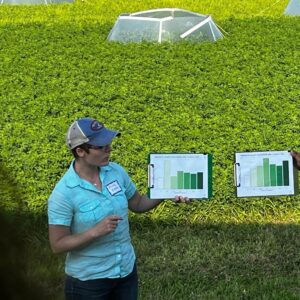
- On September 3, 2024, I presented preliminary data in Spanish to visiting Latinx farmers during a research plot field tour sponsored by the Rodale Institute. About 6 farmers attended. *Yes, I also presented data from another SARE grant (about cover crops) at this event as well!

Proposed/Anticipated
Through this project, I will initiate outreach activities to both English and Spanish audiences at academic and grower conferences, extension field days, and public events. As described previously, building bridges with Spanish speakers in the agricultural industry and plant sciences has been a priority for me since I studied Spanish in college.
In 2025, I will present my research to an academic audience through an oral or poster presentation at the Ecological Society of America (ESA) Annual Meeting.
This past summer, I had the privilege of presenting at a PSU Extension Weed Science Field Day at our test plots in Rock Springs. For the same event in summer 2025, I will briefly discuss our results to visiting industry representatives and producers. This event will include examples of perennial crops, weeds, and a posterboard with large graphs and images.
Lastly, I will share key results with the public and agriculturalists at Penn State Extension Ag Progress Days in August 2025. This will be a much more informal outreach event and would involve a posterboard of graphs and images in a non-scientific format for easy explanation.
By January 2026, we will submit a manuscript on weed seed mortality in perennial systems to the Journal of Applied Ecology to disseminate our findings to a broader audience.
